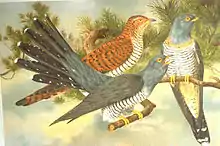Edward Jenner
Edward Jenner FRS FRCPE[1] (17 May 1749 – 26 January 1823) was an English physician and scientist who pioneered the concept of vaccines and created the smallpox vaccine, the world's first vaccine.[2][3] The terms vaccine and vaccination are derived from Variolae vaccinae ('pustules of the cow'), the term devised by Jenner to denote cowpox. He used it in 1798 in the title of his Inquiry into the Variolae vaccinae known as the Cow Pox, in which he described the protective effect of cowpox against smallpox.[4]
Edward Jenner | |
|---|---|
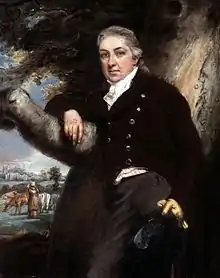 | |
| Born | 17 May 1749 Berkeley, Gloucestershire, England |
| Died | 26 January 1823 (aged 73) Berkeley, Gloucestershire, England |
| Alma mater | |
| Known for | |
| Spouse |
Catherine Kingscope
(m. 1788; died 1815) |
| Children | 3 |
| Scientific career | |
| Fields | Medicine/surgery, natural history |
| Academic advisors | John Hunter |
In the West, Jenner is often called "the father of immunology",[5] and his work is said to have saved "more lives than any other man".[6]: 100 [7] In Jenner's time, smallpox killed around 10% of global population, with the number as high as 20% in towns and cities where infection spread more easily.[7] In 1821, he was appointed physician to King George IV, and was also made mayor of Berkeley and justice of the peace. He was a member of the Royal Society. In the field of zoology, he was among the first modern scholars to describe the brood parasitism of the cuckoo (Aristotle also noted this behaviour in his History of Animals). In 2002, Jenner was named in the BBC's list of the 100 Greatest Britons.
Early life
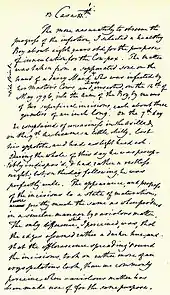
Edward Jenner was born on 17 May 1749[8] in Berkeley, Gloucestershire, England as the eighth of nine children. His father, the Reverend Stephen Jenner, was the vicar of Berkeley, so Jenner received a strong basic education.[8]
Education and training
When he was young, he went to school in Wotton-under-Edge at Katherine Lady Berkeley's School and in Cirencester.[8] During this time, he was inoculated (by variolation) for smallpox, which had a lifelong effect upon his general health.[8] At the age of 14, he was apprenticed for seven years to Daniel Ludlow, a surgeon of Chipping Sodbury, South Gloucestershire, where he gained most of the experience needed to become a surgeon himself.[8]

In 1770, aged 21, Jenner became apprenticed in surgery and anatomy under surgeon John Hunter and others at St George's Hospital, London.[9] William Osler records that Hunter gave Jenner William Harvey's advice, well known in medical circles (and characteristic of the Age of Enlightenment), "Don't think; try."[10] Hunter remained in correspondence with Jenner over natural history and proposed him for the Royal Society. Returning to his native countryside by 1773, Jenner became a successful family doctor and surgeon, practising on dedicated premises at Berkeley. In 1792, "with twenty years' experience of general practice and surgery, Jenner obtained the degree of MD from the University of St Andrews".[3]
Later life
Jenner and others formed the Fleece Medical Society or Gloucestershire Medical Society, so called because it met in the parlour of the Fleece Inn, Rodborough, Gloucestershire. Members dined together and read papers on medical subjects. Jenner contributed papers on angina pectoris, ophthalmia, and cardiac valvular disease and commented on cowpox. He also belonged to a similar society which met in Alveston, near Bristol.[11]
He became a master mason on 30 December 1802, in Lodge of Faith and Friendship #449. From 1812 to 1813, he served as worshipful master of Royal Berkeley Lodge of Faith and Friendship.[12]
Zoology
Jenner was elected fellow of the Royal Society in 1788, following his publication of a careful study of the previously misunderstood life of the nested cuckoo, a study that combined observation, experiment, and dissection.
Jenner described how the newly hatched cuckoo pushed its host's eggs and fledgling chicks out of the nest (contrary to existing belief that the adult cuckoo did it).[13] Having observed this behaviour, Jenner demonstrated an anatomical adaptation for it – the baby cuckoo has a depression in its back, not present after 12 days of life, that enables it to cup eggs and other chicks. The adult does not remain long enough in the area to perform this task. Jenner's findings were published in Philosophical Transactions of the Royal Society in 1788.[14][15]
"The singularity of its shape is well adapted to these purposes; for, different from other newly hatched birds, its back from the scapula downwards is very broad, with a considerable depression in the middle. This depression seems formed by nature for the design of giving a more secure lodgement to the egg of the Hedge-sparrow, or its young one, when the young Cuckoo is employed in removing either of them from the nest. When it is about twelve days old, this cavity is quite filled up, and then the back assumes the shape of nestling birds in general."[16] Jenner's nephew assisted in the study. He was born on 30 June 1737.
Jenner's understanding of the cuckoo's behaviour was not entirely believed until the artist Jemima Blackburn, a keen observer of birdlife, saw a blind nestling pushing out a host's egg. Blackburn's description and illustration were enough to convince Charles Darwin to revise a later edition of On the Origin of Species.[17]
Jenner's interest in zoology played a large role in his first experiment with inoculation. Not only did he have a profound understanding of human anatomy due to his medical training, but he also understood animal biology and its role in human-animal trans-species boundaries in disease transmission. At the time, there was no way of knowing how important this connection would be to the history and discovery of vaccinations. We see this connection now; many present-day vaccinations include animal parts from cows, rabbits, and chicken eggs, which can be attributed to the work of Jenner and his cowpox/smallpox vaccination.[18]
Marriage and human medicine

Jenner married Catherine Kingscote (who died in 1815 from tuberculosis) in March 1788. He might have met her while he and other fellows were experimenting with balloons. Jenner's trial balloon descended into Kingscote Park, Gloucestershire, owned by Catherine's father Anthony Kingscote.[19] They had three children: Edward Robert (1789–1810), Robert Fitzharding (1792–1854) and Catherine (1794–1833).[20]
He earned his MD from the University of St Andrews in 1792.[21] He is credited with advancing the understanding of angina pectoris.[22] In his correspondence with Heberden, he wrote: "How much the heart must suffer from the coronary arteries not being able to perform their functions".[23]
Invention of the vaccine


Inoculation was already a standard practice in Asian and African medicine but involved serious risks, including the possibility that those inoculated would become contagious and spread the disease to others.[24] In 1721, Lady Mary Wortley Montagu had imported variolation to Britain after having observed it in Istanbul. While Johnnie Notions had great success with his self-devised inoculation[25] (and was reputed not to have lost a single patient),[26] his method's practice was limited to the Shetland Isles. Voltaire wrote that at this time 60% of the population caught smallpox and 20% of the population died from it.[27] Voltaire also states that the Circassians used the inoculation from times immemorial, and the custom may have been borrowed by the Turks from the Circassians.[28] In 1766, Daniel Bernoulli analysed smallpox morbidity and mortality data to demonstrate the efficacy of inoculation.[29]

By 1768, English physician John Fewster had realised that prior infection with cowpox rendered a person immune to smallpox.[30][31] In the years following 1770, at least five investigators in England and Germany (Sevel, Jensen, Jesty 1774, Rendell, Plett 1791) successfully tested in humans a cowpox vaccine against smallpox.[32] For example, Dorset farmer Benjamin Jesty[33] successfully vaccinated and presumably induced immunity with cowpox in his wife and two children during a smallpox epidemic in 1774, but it was not until Jenner's work that the procedure became widely understood. Jenner may have been aware of Jesty's procedures and success.[34] A similar observation was later made in France by Jacques Antoine Rabaut-Pommier in 1780.[35]
Jenner postulated that the pus in the blisters that affected individuals affected by cowpox (a disease similar to smallpox, but much less virulent) protected them from smallpox. On 14 May 1796, Jenner tested his hypothesis by inoculating James Phipps, an eight-year-old boy who was the son of Jenner's gardener. He scraped pus from cowpox blisters on the hands of Sarah Nelmes, a milkmaid who had caught cowpox from a cow called Blossom,[36] whose hide now hangs on the wall of the St. George's Medical School library (now in Tooting). Phipps was the 17th case described in Jenner's first paper on vaccination.[37]
| Jenner's Hypothesis: |
|---|
| The initial source of infection was a disease of horses, called "the grease", which was transferred to cattle by farm workers, transformed, and then manifested as cowpox. |
.jpg.webp)
Jenner inoculated Phipps in both arms that day, subsequently producing in Phipps a fever and some uneasiness, but no full-blown infection. Later, he injected Phipps with variolous material, the routine method of immunization at that time. No disease followed. The boy was later challenged with variolous material and again showed no sign of infection. No unexpected side effects occurred, and neither Phipps nor any other recipients underwent any future 'breakthrough' cases.
Jenner's biographer John Baron would later speculate that Jenner understood one could be inoculated against smallpox by being exposed to cowpox by observing the unblemished complexion of milkmaids, rather than building on the work of his predecessors. The milkmaids story is still widely repeated even though it appears to be a myth.[38][39]
| Known: |
|---|
| Smallpox is more dangerous than variolation and cowpox less dangerous than variolation. |
| Hypothesis: |
| If target is infected with cowpox, then target is immune to smallpox. |
| Test: |
| If variolation after infection with cowpox fails to produce a smallpox infection, immunity to smallpox has been achieved. |
| Consequence: |
| Immunity to smallpox can be induced much more safely than by variolation. |
Donald Hopkins has written, "Jenner's unique contribution was not that he inoculated a few persons with cowpox, but that he then proved [by subsequent challenges] that they were immune to smallpox. Moreover, he demonstrated that the protective cowpox pus could be effectively inoculated from person to person, not just directly from cattle."[40] Jenner successfully tested his hypothesis on 23 additional subjects.


Jenner continued his research and reported it to the Royal Society, which did not publish the initial paper. After revisions and further investigations, he published his findings on the 23 cases, including his 11-month-old son Robert.[41] Some of his conclusions were correct, some erroneous; modern microbiological and microscopic methods would make his studies easier to reproduce. The medical establishment deliberated at length over his findings before accepting them. Eventually, vaccination was accepted, and in 1840, the British government banned variolation – the use of smallpox to induce immunity – and provided vaccination using cowpox free of charge (see Vaccination Act).
The success of his discovery soon spread around Europe and was used en masse in the Spanish Balmis Expedition (1803–1806), a three-year-long mission to the Americas, the Philippines, Macao, China, led by Francisco Javier de Balmis with the aim of giving thousands the smallpox vaccine.[42] The expedition was successful, and Jenner wrote: "I don't imagine the annals of history furnish an example of philanthropy so noble, so extensive as this".[43] Napoleon, who at the time was at war with Britain, had all his French troops vaccinated, awarded Jenner a medal, and at the request of Jenner, he released two English prisoners of war and permitted their return home.[44][45] Napoleon remarked he could not "refuse anything to one of the greatest benefactors of mankind".[44]

Jenner's continuing work on vaccination prevented him from continuing his ordinary medical practice. He was supported by his colleagues and the King in petitioning Parliament,[46] and was granted £10,000 in 1802 for his work on vaccination.[47] In 1807, he was granted another £20,000 after the Royal College of Physicians confirmed the widespread efficacy of vaccination.[3]
Later life

Jenner was later elected a foreign honorary member of the American Academy of Arts and Sciences in 1802, a member of the American Philosophical Society in 1804,[48] and a foreign member of the Royal Swedish Academy of Sciences in 1806.[49] In 1803 in London, he became president of the Jennerian Society, concerned with promoting vaccination to eradicate smallpox. The Jennerian ceased operations in 1809. Jenner became a member of the Medical and Chirurgical Society on its founding in 1805 (now the Royal Society of Medicine) and presented several papers there. In 1808, with government aid, the National Vaccine Establishment was founded, but Jenner felt dishonoured by the men selected to run it and resigned his directorship.[6]: 122–125
Returning to London in 1811, Jenner observed a significant number of cases of smallpox after vaccination. He found that in these cases the severity of the illness was notably diminished by previous vaccination. In 1821, he was appointed physician extraordinary to King George IV, and was also made mayor of Berkeley[3] and magistrate[6]: 303 (justice of the peace). He continued to investigate natural history, and in 1823, the last year of his life, he presented his "Observations on the Migration of Birds" to the Royal Society.[47]
Death
Jenner was found in a state of apoplexy on 25 January 1823, with his right side paralysed.[6]: 314 He did not recover and died the next day of an apparent stroke, his second, on 26 January 1823,[6] aged 73. He was buried in the family vault at the Church of St Mary, Berkeley.[52]
Religious views

Neither fanatic nor lax,[53] Jenner was a Christian who in his personal correspondence showed himself quite spiritual.[6]: 141 Some days before his death, he stated to a friend: "I am not surprised that men are not grateful to me; but I wonder that they are not grateful to God for the good which He has made me the instrument of conveying to my fellow creatures".[6]: 295
Legacy
In 1980, the World Health Organization declared smallpox an eradicated disease.[54] This was the result of coordinated public health efforts, but vaccination was an essential component. Although the disease was declared eradicated, some pus samples still remain in laboratories in Centers for Disease Control and Prevention in Atlanta in the US, and in State Research Center of Virology and Biotechnology VECTOR in Koltsovo, Novosibirsk Oblast, Russia.[55]
Jenner's vaccine laid the foundation for contemporary discoveries in immunology.[56] In 2002, Jenner was named in the BBC's list of the 100 Greatest Britons following a UK-wide vote.[57] Commemorated on postage stamps issued by the Royal Mail, in 1999 he featured in their World Changers issue along with Charles Darwin, Michael Faraday and Alan Turing.[58] The lunar crater Jenner is named in his honour.[59]
Monuments and buildings
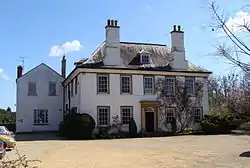
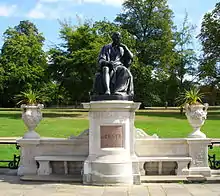

- Jenner's house in the village of Berkeley, Gloucestershire, is now a small museum,[3] housing, among other things, the horns of the cow, Blossom.
- A statue of Jenner by Robert William Sievier was erected in the nave of Gloucester Cathedral.[60]
- Another statue was erected in Trafalgar Square and later moved to Kensington Gardens.[61]
- Near the Gloucestershire village of Uley, Downham Hill is locally known as "Smallpox Hill" for its possible role in Jenner's studies of the disease.[62]
- London's St. George's Hospital Medical School has a Jenner Pavilion, where his bust may be found.[63]
- A group of villages in Somerset County, Pennsylvania, United States, was named in Jenner's honour by early 19th-century English settlers, including Jenners, Jenner Township, Jenner Crossroads, and Jennerstown, Pennsylvania[64]
- Jennersville, Pennsylvania, is located in Chester County.[65]
- The Edward Jenner Institute for Vaccine Research is an infectious disease vaccine research centre, also the Jenner Institute part of the University of Oxford.
- A section at Gloucestershire Royal Hospital is known as the Edward Jenner Unit; it is where blood is drawn.[66]
- A ward at Northwick Park Hospital is called Jenner Ward.[67]
- Jenner Gardens at Cheltenham, Gloucestershire, opposite one of the scientist's former offices, is a small garden and cemetery.[68]
- A statue of Jenner was erected at the Tokyo National Museum in 1896 to commemorate the centenary of Jenner's discovery of vaccination.[69]
- A monument outside the walls of the upper town of Boulogne sur Mer, France.[70]
- A street in Stoke Newington, north London: Jenner Road, N16 51.55867°N 0.06761°W
- Built around 1970, The Jenner Health Centre, 201 Stanstead Road, Forest Hill, London, SE23 1HU[71]
- Jenner's name is featured on the Frieze of the London School of Hygiene & Tropical Medicine. Twenty-three names of public health and tropical medicine pioneers were chosen to feature on the Keppel Street building when it was constructed in 1926.[72]
- Minor planet 5168 Jenner is named in his honour.[73]
Publications
- 1798 An Inquiry Into the Causes and Effects of the Variolæ Vaccinæ
- 1799 Further Observations on the Variolæ Vaccinæ, or Cow-Pox.[74]
- 1800 A Continuation of Facts and Observations relative to the Variolæ Vaccinæ 40pgs[75]
- 1801 The Origin of the Vaccine Inoculation[76]
See also
References
- "Jenner, Edward (1749–1823)". rcpe.ac.uk. Royal College of Physicians of Edinburgh. 28 January 2015. Archived from the original on 12 May 2021. Retrieved 26 June 2018.
- Riedel, Stefan (January 2005). "Edward Jenner and the history of smallpox and vaccination". Proceedings (Baylor University. Medical Center). Baylor University Medical Center. 18 (1): 21–25. doi:10.1080/08998280.2005.11928028. PMC 1200696. PMID 16200144.
- Baxby, Derrick (2009) [2004]. "Jenner, Edward (1749–1823)". Oxford Dictionary of National Biography (online ed.). Oxford University Press. doi:10.1093/ref:odnb/14749. Retrieved 2 December 2022.
- Baxby, Derrick (1999). "Edward Jenner's Inquiry; a bicentenary analysis". Vaccine. 17 (4): 301–307. doi:10.1016/s0264-410x(98)00207-2. PMID 9987167.
- "History – Edward Jenner (1749–1823)". BBC. 1 November 2006. Retrieved 28 July 2009.
- Baron, John (1838). The Life of Edward Jenner M.D. LL.D. F.R.S. Vol. 2. London: Henry Colburn. p. 310. hdl:2027/nc01.ark:/13960/t2t523s95 – via HathiTrust.
- "How did Edward Jenner test his smallpox vaccine?". The Telegraph. Telegraph Media Group. 13 May 2016. Archived from the original on 26 January 2022. Retrieved 2 December 2017.
- "About Edward Jenner". The Jenner Institute. Retrieved 12 April 2020.
- "Young Edward Jenner, Born in Berkeley". Edward Jenner Museum. Archived from the original on 14 September 2012. Retrieved 4 September 2012.
- Loncarek K (April 2009). "Revolution or reformation". Croatian Medical Journal. 50 (2): 195–197. doi:10.3325/cmj.2009.50.195. PMC 2681061. PMID 19399955.
- "Papers at the Royal College of Physicians summarised" Archived 7 November 2017 at the Wayback Machine.
- "Edward Jenner biography". Grand Lodge of British Columbia and Yukon A.F. & A. M. Retrieved 22 August 2016
- Jenner Museum: Cuckoo Archived 23 September 2009 at the Wayback Machine
- "Observations on the Natural History of the Cuckoo". By Mr. Edward Jenner. In a Letter to John Hunter, Esq. F.R.S. Jenner, E Philosophical Transactions of the Royal Society of London (1776–1886). 1788. 78:219–237 (Archived Text)
- Sealy Spencer G (2011). "Cuckoo chicks evicting their nest mates: coincidental observations by Edward Jenner in England and Antoine Joseph Lottinger in France". Archives of Natural History. 38 (2): 220–228. doi:10.3366/anh.2011.0030.
- (Letter to Hunter at the Royal Society, as above)
- The Biographical Dictionary of Scottish Women. 2006.
- Stern, Alexandra Minna; Markel, Howard (2005). "The History of Vaccines and Immunization: Familiar Patterns, New Challenges". Health Affairs. 24 (3): 611–621. doi:10.1377/hlthaff.24.3.611. PMID 15886151.
- Richard B. Fisher, Edward Jenner (Andre Deutsch, 1991) pp. 40–42
- The Journal of Genealogy and Family History, Vol. 2, No. 1 (2018)
- "A brief history of the University". University of St Andrews. Retrieved 11 February 2018.
Through the centuries many great minds have been attracted to St Andrews:...Edward Jenner, pioneer of the smallpox vaccine (MD, 1792)
- Beasley AW (2011). "A story of heartache: the understanding of angina pectoris in the pre-surgical period". The Journal of the Royal College of Physicians of Edinburgh. 41 (4): 361–365. doi:10.4997/JRCPE.2011.416. PMID 22184576.
- Valentin Fuster, Eric J. Topol, Elizabeth G. Nabel (2005). "Atherothrombosis and Coronary Artery Disease". p. 8. Lippincott Williams & Wilkins
- "Lady Montagu and the Introduction of Smallpox Inoculation to England | Muslim Heritage". www.muslimheritage.com. 16 February 2010. Retrieved 3 March 2017.
- Smith, Brian (July 1998). "Camphor, Cabbage Leaves and Vaccination: the Career of Johnie 'Notions' Williamson of Hamnavoe, Eshaness, Shetland" (PDF). Proceedings of the Royal College of Physicians of Edinburgh. Royal College of Physicians of Edinburgh. 28 (3): 402. PMID 11620446. Retrieved 12 October 2019.
- Dishington, Andrew (1999) [1792]. Sinclair, Sir John (ed.). "United Parishes of Mid and South Yell". The Statistical Account of Scotland Drawn up from the Communications of the Ministers of the Different Parishes. University of Edinburgh, University of Glasgow: Edinburgh: William Creech. 2 (50): 571. OCLC 1045293275. Retrieved 10 October 2019 – via The Statistical Accounts of Scotland online service.
- François Marie Arouet de Voltaire (1778). "Letters on the English or Lettres Philosophiques".
- "Voltaire on Circassian Medicine: Inoculation". Circassian World. Archived from the original on 8 June 2012. Retrieved 26 May 2012. from Voltaire (1733). The Works of Voltaire. Vol. XIX (Philosophical Letters).
- reprinted in Blower, S; Bernoulli, D (2004). "An attempt at a new analysis of the mortality caused by smallpox and of the advantages of inoculation to prevent it" (PDF). Reviews in Medical Virology. 14 (5): 275–288. doi:10.1002/rmv.443. PMID 15334536. S2CID 8169180. Archived from the original (PDF) on 27 September 2007.
- Pearson, George (1798). An Inquiry Concerning the History of the Cowpox, Principally with a View to Supersede and Extinguish the Smallpox. London: J. Johnson. pp. 102–104.
- Thurston, L.; Williams, G. (2015). "An examination of John Fewster's role in the discovery of smallpox vaccination" (PDF). Journal of the Royal College of Physicians of Edinburgh. 45 (2): 173–179. doi:10.4997/JRCPE.2015.217. PMID 26181536. Archived from the original (PDF) on 14 October 2022.
- Plett PC (2006). "Peter Plett and other discoverers of cowpox vaccination before Edward Jenner" [Peter Plett and other discoverers of cowpox vaccination before Edward Jenner]. Sudhoffs Archiv (in German). 90 (2): 219–232. PMID 17338405.
- Hammarsten J. F.; et al. (1979). "Who discovered smallpox vaccination? Edward Jenner or Benjamin Jesty?". Transactions of the American Clinical and Climatological Association. 90: 44–55. PMC 2279376. PMID 390826.
- Grant, John (2007). Corrupted Science: Fraud, Ideology and Politics in Science. London: Facts, Figures & Fun. p. 24. ISBN 9781904332732.
- Théodoridès J (1979). "Rabaut-Pommier, a neglected precursor of Jenner". Med Hist. 23 (4): 479–480. doi:10.1017/s0025727300052121. PMC 1082587. PMID 390274.
- "Edward Jenner & Smallpox". The Edward Jenner Museum. Archived from the original on 28 June 2009. Retrieved 13 July 2009.
- An Inquiry into the Causes and Effects of the Variolae Vaccinae, Edward Jenner. Retrieved 17 November 2012
- Boylston, Arthur (2013). "The origins of vaccination: myths and reality". Journal of the Royal Society of Medicine. 106 (9): 351–354. doi:10.1177/0141076813499292. PMC 3758677. PMID 23995824.
- Jarry, Jonathan (9 June 2023). "The White Lie at the Heart of Vaccine History". Office for Science and Society. Retrieved 12 June 2023.
- Hopkins, Donald R. (2002). The greatest killer: smallpox in history, with a new introduction. Chicago: University of Chicago Press. p. 80. ISBN 978-0226351681. OCLC 49305765.
- Williams, Gareth (2010). Angel of Death: The Story of Smallpox. Basingstoke: Palgrave Macmillan. p. 198. ISBN 978-0230274716.
- Carlos Franco-Paredes; Lorena Lammoglia; José Ignacio Santos-Preciado (2005). "The Spanish Royal Philanthropic Expedition to Bring Smallpox Vaccination to the New World and Asia in the 19th Century". Clinical Infectious Diseases. Oxford Journals. 41 (9): 1285–1289. doi:10.1086/496930. PMID 16206103.
- "Andean Studies: New Trends and Library Resources : Papers of the Forty-Fifth Annual Meeting of the Seminar on the Acquisition of Latin American Library Materials", University of California, Los Angeles ... 27–31 May 2000. p. 46
- De Beer, G. R. (May 1952). "The relations between fellows of the Royal Society and French men of science when France and Britain were at war". Notes and Records of the Royal Society of London. 9 (2): 297. doi:10.1098/rsnr.1952.0016. S2CID 202574537.
- Morgan, A.J.; Poland, Gregory A. (30 December 2011). "The Jenner Society and the Edward Jenner Museum: Tributes to a physician-scientist" (PDF). Vaccine. 29 (Supplement 4): D152–D154. doi:10.1016/j.vaccine.2011.08.128. PMID 22486976.
- Commons, Great Britain Parliament House of (18 July 2018). "Reports from Committees of the House of Commons which Have Been Printed by Order of the House: And are Not Inserted in the Journals [1715–1801]" – via Google Books.
- Lee, Sidney, ed. (1892). . Dictionary of National Biography. Vol. 29. London: Smith, Elder & Co.
- "APS Member History". search.amphilsoc.org. Retrieved 1 April 2021.
- "Book of Members, 1780–2010: Chapter J" (PDF). American Academy of Arts and Sciences. Retrieved 28 July 2014.
- "Edward Jenner". freemasonry.bcy.ca. Retrieved 14 March 2023.
- "Famous Freemasons in History | Freemason Information". 20 February 2009. Retrieved 14 March 2023.
- "Edward Jenner – St Mary's Church, Berkeley, Gloucestershire". Archived from the original on 20 September 2011. Retrieved 15 December 2010.
- Horne, Charles F. 1894. Dr. Edward Jenner (1749–1823) by John Timbs, F.S.A.. GG Archives
- World Health Organization. "Smallpox".
- "Forgotten smallpox vials found in cardboard box at Maryland laboratory". The Guardian. Retrieved 19 October 2016
- "Dr. Edward Jenner and the small pox vaccination". Essortment.com. Archived from the original on 14 April 2009. Retrieved 28 July 2009.
- "100 great British heroes". BBC News. 21 August 2002. Retrieved 13 October 2021.
- "Issue: World Changers (21.09.1999)". BFDC. Retrieved 30 September 2022.
- "Planetary Names: Crater, craters: Jenner on Moon". Gazetteer of Planetary Nomenclature (IAU). Archived from the original on 31 May 2018. Retrieved 13 October 2021.
- Herbert, N.M., ed. (1988). "Gloucester: The cathedral and close". A History of the County of Gloucester. Victoria County History. Vol. 4: The City of Gloucester. London: Oxford University Press for the Institute of Historical Research. pp. 275–288. Retrieved 7 November 2006.
- Royal College of Physicians. "Jenner, Edward (1749–1750)". AIM25 Archives. Archived from the original on 7 November 2017. Retrieved 19 February 2006.
- Bala, Divya; Badrinath, Chan (2013). "Edward Jenner (1749–1823)". The National Medical Graduates Club. Retrieved 13 May 2018.
- St George's, University of London. "Our History". Archived from the original on 10 November 2010. Retrieved 25 August 2006.
- History of Bedford, Somerset, and Fulton Counties, Pennsylvania: With Illustrations and Biographical Sketches of Some of Its Pioneers and Prominent Men. Waterman, Watkins & Co. 1884. pp. 503–508.
- "History and Demographics, Chester County, Pennsylvania". Penn Township. Archived from the original on 13 May 2018. Retrieved 13 May 2018.
- "Edward Jenner Unit". Gloucestershire Hospitals. NHS Foundation Trust. Retrieved 13 May 2018.
- "Northwick Park and St Mark's Hospital ward phone numbers". London North West University Healthcare. Retrieved 12 May 2018.
- "Jenner Gardens". Cheltenham.gov.uk. Retrieved 8 December 2017
- "Top 10 Tokyo". p. 27. Dorling Kindersley Ltd, 2017
- "Monument à Edward Jenner – Boulogne-sur-Mer". e-monumen.net (in French). L'Association pour la sauvegarde et la promotion du patrimoine métallurgique haut-marnais. Retrieved 13 May 2018.
- "The Jenner Practice". Retrieved 28 July 2020.
- "Behind the Frieze". LSHTM. Archived from the original on 22 February 2017. Retrieved 21 February 2017.
- "(5168) Jenner". Dictionary of Minor Planet Names. Springer. 2003. p. 445. doi:10.1007/978-3-540-29925-7_5016. ISBN 978-3540299257.
- Edward Jenner. (6 September 2022). "Further Observations on the Variolæ Vaccinæ, or Cow-Pox. 1799". The Harvard Classics, 1909–1914.
- Edward Jenner. (6 September 2022). "A Continuation of Facts and Observations Relative to the Variolæ Vaccinæ, or Cow-Pox. 1800". The Harvard Classics, 1909–1914.
- "The origins of vaccination: no inoculation, no vaccination". James Lind Initiative, the Royal College of Physicians of Edinburgh and Minervation Ltd
Further reading
- Papers at the Royal College of Physicians Archived 7 November 2017 at the Wayback Machine
- Baron, John (1827). The Life of Edward Jenner M.D. LL.D. F.R.S. London: Henry Colburn. OCLC 841887455 – via Internet Archive.
- Baron, John (1838). The Life of Edward Jenner M.D. LL.D. F.R.S. Vol. 1. London: Henry Colburn. hdl:2027/nc01.ark:/13960/t5t80td4m – via HathiTrust.
- Baron, John (1838). The Life of Edward Jenner M.D. LL.D. F.R.S. Vol. 2. London: Henry Colburn. hdl:2027/nc01.ark:/13960/t2t523s95 – via HathiTrust.
- Underwood, E. Ashworth (21 May 1949). "Edward Jenner: the Man and His Work". British Medical Journal. 1 (4611): 881–884. doi:10.1136/bmj.1.4611.881. PMC 2050111. PMID 20787561.
- Fisher, Richard B., Edward Jenner 1749–1823, Andre Deutsch, London, 1991.
- Bennett, Michael, War against Smallpox. Edward Jenner and the Global Spread of Vaccination, Cambridge University Press, Cambridge, 2020.
- Cartwright K (October 2005). "From Jenner to modern smallpox vaccines". Occupational Medicine. 55 (7): 563. doi:10.1093/occmed/kqi163. PMID 16251374.
- Riedel S (January 2005). "Edward Jenner and the history of smallpox and vaccination". Proceedings. 18 (1): 21–25. doi:10.1080/08998280.2005.11928028. PMC 1200696. PMID 16200144.
- Tan SY (November 2004). "Edward Jenner (1749–1823): conqueror of smallpox" (PDF). Singapore Medical Journal. 45 (11): 507–508. PMID 15510320.
- van Oss CJ (November 2000). "Inoculation against smallpox as the precursor to vaccination". Immunological Investigations. 29 (4): 443–446. PMID 11130785.
- Gross CP, Sepkowitz KA (1998). "The myth of the medical breakthrough: smallpox, vaccination, and Jenner reconsidered". International Journal of Infectious Diseases. 3 (1): 54–60. doi:10.1016/S1201-9712(98)90096-0. PMID 9831677.
- Willis NJ (August 1997). "Edward Jenner and the eradication of smallpox". Scottish Medical Journal. 42 (4): 118–121. doi:10.1177/003693309704200407. PMID 9507590. S2CID 43179073.
- Theves G (1997). "Smallpox: an historical review" [Smallpox: an historical review]. Bulletin de la Société des Sciences Médicales du Grand-Duché de Luxembourg (in German). 134 (1): 31–51. PMID 9303824.
- Kempa ME (December 1996). "Edward Jenner (1749–1823) – benefactor to mankind (100th anniversary of the first vaccination against smallpox)". Polski Merkuriusz Lekarski (in Polish). 1 (6): 433–434. PMID 9273243.
- Baxby D (November 1996). "The Jenner bicentenary: the introduction and early distribution of smallpox vaccine". FEMS Immunology and Medical Microbiology. 16 (1): 1–10. doi:10.1111/j.1574-695X.1996.tb00105.x. PMID 8954347.
- Larner AJ (September 1996). "Smallpox". The New England Journal of Medicine. 335 (12): 901, author reply 902. doi:10.1056/nejm199609193351217. PMID 8778627.
- Aly A, Aly S (September 1996). "Smallpox". The New England Journal of Medicine. 335 (12): 900–901, author reply 902. doi:10.1056/NEJM199609193351217. PMID 8778626.
- Magner J (September 1996). "Smallpox". The New England Journal of Medicine. 335 (12): 900–902. doi:10.1056/NEJM199609193351217. PMID 8778624.
- Kumate-Rodríguez J (1996). "Bicentennial of smallpox vaccine: experiences and lessons" [Bicentennial of smallpox vaccine: experiences and lessons]. Salud Pública de México (in Spanish). 38 (5): 379–385. PMID 9092091.
- Budai J (August 1996). "200th anniversary of the Jenner smallpox vaccine" [200th anniversary of the Jenner smallpox vaccine]. Orvosi Hetilap (in Hungarian). 137 (34): 1875–1877. PMID 8927342.
- Rathbone J (June 1996). "Lady Mary Wortley Montague's contribution to the eradication of smallpox". Lancet. 347 (9014): 1566. doi:10.1016/S0140-6736(96)90724-2. PMID 8684145. S2CID 36862611.
- Baxby D (June 1996). "The Jenner bicentenary; still uses for smallpox vaccine". Epidemiology and Infection. 116 (3): 231–34. doi:10.1017/S0950268800052523. PMC 2271423. PMID 8666065.
- Cook GC (May 1996). "Dr William Woodville (1752–1805) and the St Pancras Smallpox Hospital". Journal of Medical Biography. 4 (2): 71–78. doi:10.1177/096777209600400202. PMID 11616267. S2CID 20098740.
- Baxby D (1996). "Jenner and the control of smallpox". Transactions of the Medical Society of London. 113: 18–22. PMID 10326082.
- Dunn PM (January 1996). "Dr Edward Jenner (1749–1823) of Berkeley, and vaccination against smallpox". Archives of Disease in Childhood. 74 (1): F77–78. doi:10.1136/fn.74.1.F77. PMC 2528332. PMID 8653442.
- Meynell E (August 1995). "French reactions to Jenner's discovery of smallpox vaccination: the primary sources". Social History of Medicine. 8 (2): 285–303. doi:10.1093/shm/8.2.285. PMID 11639810.
- Bloch H (July 1993). "Edward Jenner (1749–1823). The history and effects of smallpox, inoculation, and vaccination". American Journal of Diseases of Children. 147 (7): 772–774. doi:10.1001/archpedi.1993.02160310074022. PMID 8322750.
- Roses DF (October 1992). "From Hunter and the Great Pox to Jenner and smallpox". Surgery, Gynecology & Obstetrics. 175 (4): 365–72. PMID 1411896.
- Turk JL, Allen E (April 1990). "The influence of John Hunter's inoculation practice on Edward Jenner's discovery of vaccination against smallpox". Journal of the Royal Society of Medicine. 83 (4): 266–267. doi:10.1177/014107689008300419. PMC 1292617. PMID 2187990.
- Poliakov VE (December 1985). "Edward Jenner and vaccination against smallpox" [Edward Jenner and vaccination against smallpox]. Meditsinskaia Sestra (in Russian). 44 (12): 49–51. PMID 3912642.
- Hammarsten JF, Tattersall W, Hammarsten JE (1979). "Who discovered smallpox vaccination? Edward Jenner or Benjamin Jesty?". Transactions of the American Clinical and Climatological Association. 90: 44–55. PMC 2279376. PMID 390826.
- Rodrigues BA (1975). "Smallpox eradication in the Americas". Bulletin of the Pan American Health Organization. 9 (1): 53–68. PMID 167890.
- Wynder EL (March 1974). "A corner of history: Jenner and his smallpox vaccine". Preventive Medicine. 3 (1): 173–175. doi:10.1016/0091-7435(74)90074-7. PMID 4592685.
- Andreae H (June 1973). "Edward Jenner, initiator of cowpox vaccination against human smallpox, died 150 years ago" [Edward Jenner, initiator of cowpox vaccination against human smallpox, died 150 years ago]. Das Offentliche Gesundheitswesen (in German). 35 (6): 366–367. PMID 4269783.
- Friedrich I (February 1973). "A cure for smallpox. On the 150th anniversary of Edward Jenner's death". Orvosi Hetilap (in Hungarian). 114 (6): 336–338. PMID 4567814.
- MacNalty AS (January 1968). "The prevention of smallpox: from Edward Jenner to Monckton Copeman". Medical History. 12 (1): 1–18. doi:10.1017/s0025727300012722. PMC 1033768. PMID 4867646.
- Udovitskaia EF (November 1966). "Edward Jenner and the history of his scientific achievement. (On the 170th anniversary of the discovery of smallpox vaccination)" [Edward Jenner and the history of his scientific achievement. (On the 170th anniversary of the discovery of smallpox vaccination)]. Vrachebnoe Delo (in Russian). 11: 111–115. PMID 4885910.
- Voigt K (1964). "The Pharmacy Displa Window. Edward Jenner Discovered Smallpox Vaccination" [The Pharmacy Display Window. Edward Jenner Discovered Smallpox Vaccination]. Pharmazeutische Praxis (in German). 106: 88–89. PMID 14237138.
- Ordnance Survey showing reference to Smallpox Hil: http://explore.ordnancesurvey.co.uk/os_routes/show/1539 Archived 3 February 2011 at the Wayback Machine
- Davies JW (1970). "A historical note on the Reverend John Clinch, first Canadian vaccinator". CMAJ. 102 (9): 957–961. PMC 1946720. PMID 4951061.
- Roberts KB (1978). "Smallpox: an historic disease". Memorial University of Newfoundland Occas Papers Med Hist. 1: 31–39.
- LeFanu WR. 1951 A bio-bibliography of Edward Jenner, 1749–1823. London: Harvey and Blythe; 1951. pp. 103–108.
- Smallpox Zero. Johannesburg, South Africa: African Comic Production House. 2010. ISBN 978-0620437653. Archived from the original on 19 January 2012.
External links
- Works by Edward Jenner at Project Gutenberg
- Works by Edward Jenner at LibriVox (public domain audiobooks)

- Works by or about Edward Jenner at Internet Archive
- The Three Original Publications on Vaccination Against Smallpox
- A digitized copy of An inquiry into the causes and effects of the variola vaccine (1798), from the Posner Memorial Collection at Carnegie Mellon
- Dr Jenner's House, Museum and Garden, Berkeley
- The Evolution of Modern Medicine. Osler, W (FTP)
